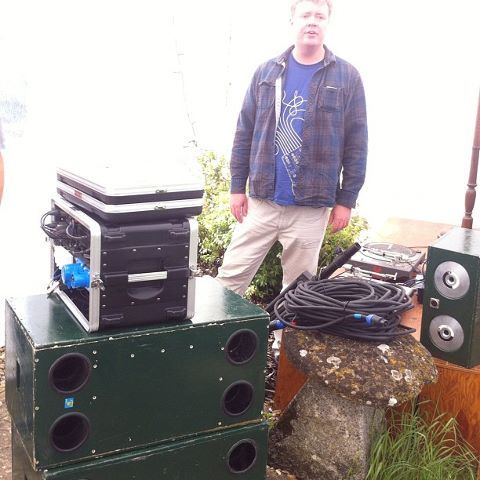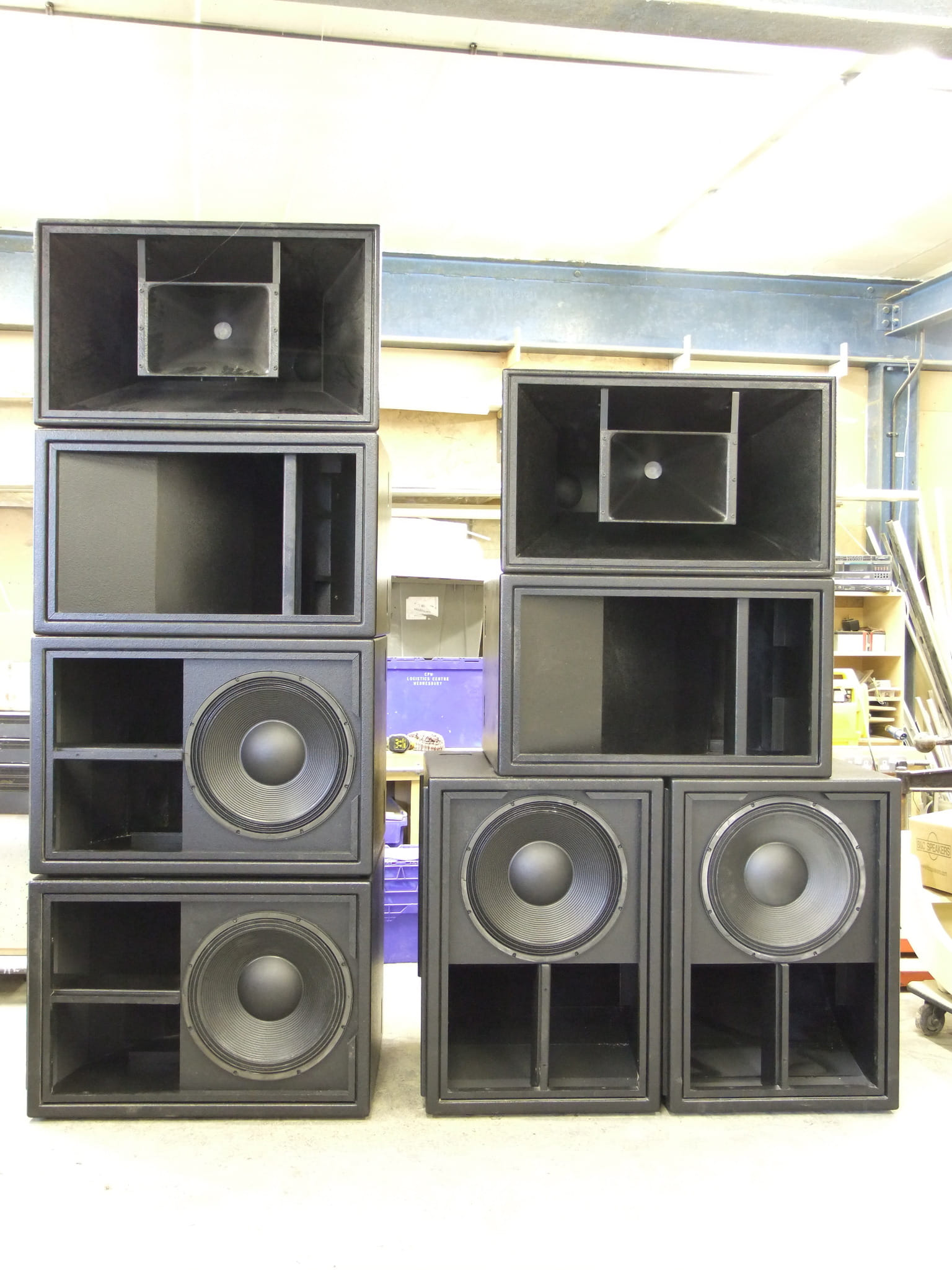- Posts: 236
- Thank you received: 0
old amps more badass looking
- jsg
-
 Topic Author
Topic Author
- Offline
- Elite Member
-

Less
More
16 years 7 months ago #5734
by jsg
Ars est celare artem
old amps more badass looking was created by jsg
There's a thread on the other forum with lots of pics of amplifiers. I can't help noticing that old amps from the 70s look more "badass" internally than modern ones which my be much more powerful. In particular:
- An old amp has big-ass TO3 transistors on big-ass heatsinks which look the business
Modern amps use plastic package devices. There's not much difference because either way the actual "transistor bit" is bonded to the metal base and the heat goes straight down into the heatsink. Plastic parts are cheaper to make so you can afford more, and you can fit more onto your heatsink, spreading out the current and heat flow.
Heatsinks themselves are increasingly ducted-fan, so the fins are all on the inside, in the duct, instead of precociously sticking out in all directions.
- An old amp has hardcore specialist "powerlytic" supercaps the size of coke cans on special mounts
Modern amps get the same capacitance by paralleling up a few big-ish ordinary caps. It's cheaper because they're more standard parts. Multiple caps also have more surface area and can lose heat more easily.
- An old amp features a monster EI core mains transformer that looks like it belongs in a substation because of its sheer unadulaterated bigness.
Toroidals became "de rigeur" as soon as they figured out how to wind them, but they're smaller and don't have the same "victorian engineering" feel as EI types. Modern switchers use ferrite cores that can support over 10 volts per turn - which means massive power through a tiny transformer. Cheaper, obviously, and also less voltage sag at full loading.
- An old amp has heavy-duty internal metalwork with heavy duty wiring looms fixed in place every 2 inches so you absolutely know that wire's not going anywhere - showing the badass seriousness of the designers.
Now much wiring is replaced by PCBs since the cost of assembly is much lower - solder parts to PCB, screw PCB in place, done. Mechanically, the outer case is used more. Fans are attached to the case rather than some internal baffle. Large internal parts are attached to bottom *and* top of the case, getting much more strength from much lighter mechanicals.
Of course, the old amps may have withstood more mechanical abuse than new ones. But they were legendary for their unreliability from an elecronic POV. Exploding caps, DC into driver, insufficient protection etc etc. Now, midrange amps can re-invest what they save on massive victorian bridge beams into comprehensive fault detection and ample margin on the components that tend to fail.
- An old amp has big-ass TO3 transistors on big-ass heatsinks which look the business
Modern amps use plastic package devices. There's not much difference because either way the actual "transistor bit" is bonded to the metal base and the heat goes straight down into the heatsink. Plastic parts are cheaper to make so you can afford more, and you can fit more onto your heatsink, spreading out the current and heat flow.
Heatsinks themselves are increasingly ducted-fan, so the fins are all on the inside, in the duct, instead of precociously sticking out in all directions.
- An old amp has hardcore specialist "powerlytic" supercaps the size of coke cans on special mounts
Modern amps get the same capacitance by paralleling up a few big-ish ordinary caps. It's cheaper because they're more standard parts. Multiple caps also have more surface area and can lose heat more easily.
- An old amp features a monster EI core mains transformer that looks like it belongs in a substation because of its sheer unadulaterated bigness.
Toroidals became "de rigeur" as soon as they figured out how to wind them, but they're smaller and don't have the same "victorian engineering" feel as EI types. Modern switchers use ferrite cores that can support over 10 volts per turn - which means massive power through a tiny transformer. Cheaper, obviously, and also less voltage sag at full loading.
- An old amp has heavy-duty internal metalwork with heavy duty wiring looms fixed in place every 2 inches so you absolutely know that wire's not going anywhere - showing the badass seriousness of the designers.
Now much wiring is replaced by PCBs since the cost of assembly is much lower - solder parts to PCB, screw PCB in place, done. Mechanically, the outer case is used more. Fans are attached to the case rather than some internal baffle. Large internal parts are attached to bottom *and* top of the case, getting much more strength from much lighter mechanicals.
Of course, the old amps may have withstood more mechanical abuse than new ones. But they were legendary for their unreliability from an elecronic POV. Exploding caps, DC into driver, insufficient protection etc etc. Now, midrange amps can re-invest what they save on massive victorian bridge beams into comprehensive fault detection and ample margin on the components that tend to fail.
Ars est celare artem
Please Log in or Create an account to join the conversation.
- chaudio
-

- Offline
- Platinum Member
-

16 years 7 months ago #5735
by chaudio
Replied by chaudio on topic old amps more badass looking
Can't fault any of the info, I'd agree with all of that.
As an amp repairer and now a newbie designer too I've seen a good selection of amps and thought about how I'd want mine built.
One thing you don't mention much on is servicability. Some amps are easy to work on, often the well designed modern ones. What I like to be able to do is disconnect the offending section and remove it from the case to repair. With a lot of older amps I often wonder how they ever managed to assemble it in the first place. The rats nest of wiring is often a nightmare and the worst ones are where the PCBs seem to be bigger than the space available to get it out of the case with all of the components on it.
Many of the component differences are due to advances in technology. Capacitors have got slightly smaller for the same value and less expensive. Multiple PCB mounted caps are easier to work with and can actually give better performance than one large one. Output transistors can handle more power per device although you're still limited by conducting the heat away faster. One big difference is that many older amps tended to be class AB on all power ratings. Once you start getting towards 1kW and above you're dissipating a lot of heat and need lots of devices. Modern amps tend to change over to class H (multiple tiers of supply rails) at lower power ratings which reduces the heat you need to get rid of and allows you to get more power from a smaller space.
On very modern amps, surface mount technology now allows especially the low power circuitry to be fit into a very small space.
My plan is to design each channel as a module which connects to the power supply and input/output by multi-pin connectors to make assembly and (the hopefully rare!) servicing easy. In terms of looks I really like the simple, heavy duty look like the old Crests, C-Audio etc. Heavy guage black aluminium front panels are the way to go methinks.
As an amp repairer and now a newbie designer too I've seen a good selection of amps and thought about how I'd want mine built.
One thing you don't mention much on is servicability. Some amps are easy to work on, often the well designed modern ones. What I like to be able to do is disconnect the offending section and remove it from the case to repair. With a lot of older amps I often wonder how they ever managed to assemble it in the first place. The rats nest of wiring is often a nightmare and the worst ones are where the PCBs seem to be bigger than the space available to get it out of the case with all of the components on it.
Many of the component differences are due to advances in technology. Capacitors have got slightly smaller for the same value and less expensive. Multiple PCB mounted caps are easier to work with and can actually give better performance than one large one. Output transistors can handle more power per device although you're still limited by conducting the heat away faster. One big difference is that many older amps tended to be class AB on all power ratings. Once you start getting towards 1kW and above you're dissipating a lot of heat and need lots of devices. Modern amps tend to change over to class H (multiple tiers of supply rails) at lower power ratings which reduces the heat you need to get rid of and allows you to get more power from a smaller space.
On very modern amps, surface mount technology now allows especially the low power circuitry to be fit into a very small space.
My plan is to design each channel as a module which connects to the power supply and input/output by multi-pin connectors to make assembly and (the hopefully rare!) servicing easy. In terms of looks I really like the simple, heavy duty look like the old Crests, C-Audio etc. Heavy guage black aluminium front panels are the way to go methinks.
Please Log in or Create an account to join the conversation.
- jsg
-
 Topic Author
Topic Author
- Offline
- Elite Member
-

Less
More
- Posts: 236
- Thank you received: 0
16 years 7 months ago #5738
by jsg
Ars est celare artem
Replied by jsg on topic old amps more badass looking
I used to build amps (around the Maplin Mosfet module) but they weren't very good - preamp circuitry was noisy, I'd be constantly dogged by bad connections and dirty tracks on pots, poor earth layout would cause motorboating and my resevoir caps would degrade.
Plus points were inventing half-bridging (put L into ch1 and -R into ch.2; hang sub between outptus, put tops on ch 1 and 2 with rch reversed, all with passive xover) and a sort of plug-in-card type deal for low power circuits like preamp, bridger, VU meter, fan control etc.
The Cloud multiway amps are modular inside, may be worth a look.
I like the idea of an amp with a single PSU and a lot of channels, whereby some are bridged for higher powers and some not. This way, you could power tops (not bridged) and subs (bridged) in the same system from a single PSU.
Plus points were inventing half-bridging (put L into ch1 and -R into ch.2; hang sub between outptus, put tops on ch 1 and 2 with rch reversed, all with passive xover) and a sort of plug-in-card type deal for low power circuits like preamp, bridger, VU meter, fan control etc.
The Cloud multiway amps are modular inside, may be worth a look.
I like the idea of an amp with a single PSU and a lot of channels, whereby some are bridged for higher powers and some not. This way, you could power tops (not bridged) and subs (bridged) in the same system from a single PSU.
Ars est celare artem
Please Log in or Create an account to join the conversation.
- tony.a.s.s.
-

- Offline
- Moderator
-

Less
More
- Posts: 1344
- Thank you received: 12
16 years 6 months ago #5890
by tony.a.s.s.
Peace and goodwill to all speaker builders
Replied by tony.a.s.s. on topic old amps more badass looking
I've just picked up this thread, and all I can say about old amps verses new, is that in my early years, I would get far more excited over a large 400x 400 per ch. amp than I do over todays amps. There are so many now and we are so complacent about gear. There is no doubt about the superiority of todays amps, but I guess it's like most things today that are 10 a penny. When it comes to admiring glances, I still like looking at my rack of DC300A's. ( Time for my medication, must go ).
Peace and goodwill to all speaker builders
Please Log in or Create an account to join the conversation.
- satassfaction
-

- Offline
- Senior Member
-

Less
More
- Posts: 74
- Thank you received: 0
16 years 5 months ago #5895
by satassfaction
Replied by satassfaction on topic old amps more badass looking
Well kewl thread! I totally agree wiv what CHAudio says. Amps have gotta look mean. Like proper nasty. And the heavier the better! Sadly i know bugger all 'bout the electronics of amps ...but back in the day i had a rack of H&H V800's, and a rack of V500's wiv a three way H&H crossover at the top of em, in racks i built from dismantled birch ply cabs.
If it's about looking bad, then personally the C-Audios win in my books. They're all black, wiv big old chunky handles. My favourites are the RA series, both the older ones with the verticle lights, and the latter RA series wirth the horozontal lights and the more chunky handles.
I just do not understand why amp desginers do not put lights that pulse to the beat, the H&H V800's looked so fookin' wicked when in action, as they had a large arc of LED's, that bopped to the beat of the music. The amps havin' a party too man!
Another thing that sucks is when a company discontinue a line of pukka amps, and replace them wiv something no where nr as good. I've not got any Crests, but loads of people propa rate the 8001's 9001's etc. Yet Crests latest top range isn't all that, but costs a small fortune! I just do not understand how the owners of such company's can get rid of something brill and replace it with something not as good. I could never work for people that did that, it'ld drive you round the bend! You'd be like wot the fuk! And they'ld be like - there's the door!
Much that i like my selection of C-Audios as backups and things to ogle, i settled on Crown Macrotechs (for when i'm on the road for a few years) as the way to go, as i desire reliability; and that soft start mode on C-Audio's is proper worrying, everytime you turn them on you hold your breath hoping it'll go out of the initial protect mode. The fact such awesome British companies as C-Audio and H&H aren't around anymore is a bummer as well.
If it's about looking bad, then personally the C-Audios win in my books. They're all black, wiv big old chunky handles. My favourites are the RA series, both the older ones with the verticle lights, and the latter RA series wirth the horozontal lights and the more chunky handles.
I just do not understand why amp desginers do not put lights that pulse to the beat, the H&H V800's looked so fookin' wicked when in action, as they had a large arc of LED's, that bopped to the beat of the music. The amps havin' a party too man!
Another thing that sucks is when a company discontinue a line of pukka amps, and replace them wiv something no where nr as good. I've not got any Crests, but loads of people propa rate the 8001's 9001's etc. Yet Crests latest top range isn't all that, but costs a small fortune! I just do not understand how the owners of such company's can get rid of something brill and replace it with something not as good. I could never work for people that did that, it'ld drive you round the bend! You'd be like wot the fuk! And they'ld be like - there's the door!
Much that i like my selection of C-Audios as backups and things to ogle, i settled on Crown Macrotechs (for when i'm on the road for a few years) as the way to go, as i desire reliability; and that soft start mode on C-Audio's is proper worrying, everytime you turn them on you hold your breath hoping it'll go out of the initial protect mode. The fact such awesome British companies as C-Audio and H&H aren't around anymore is a bummer as well.
Please Log in or Create an account to join the conversation.
Time to create page: 0.313 seconds